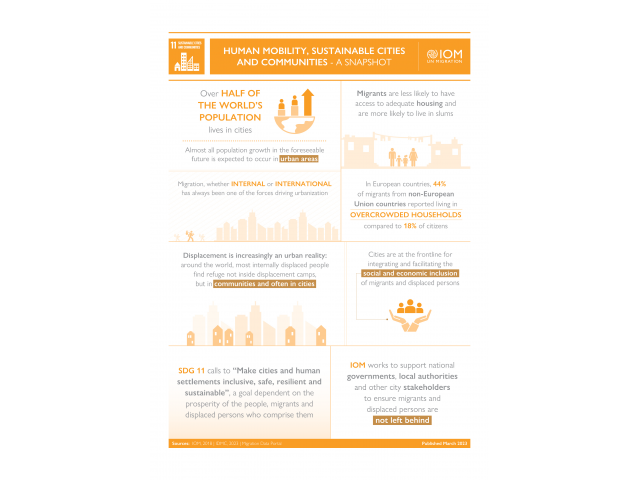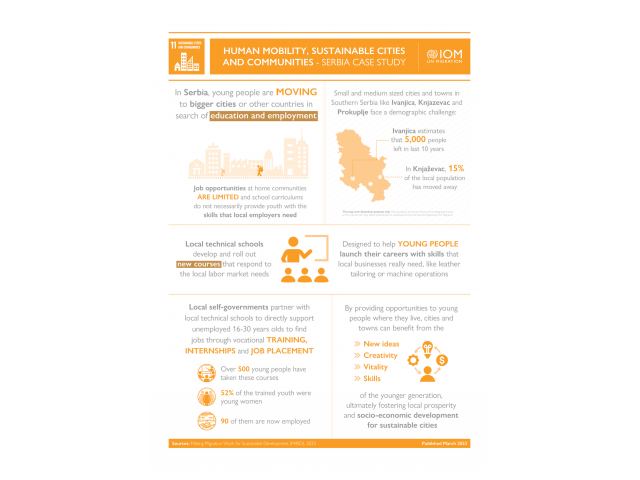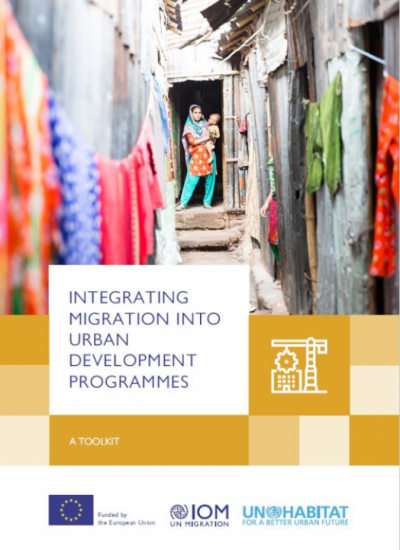SDG 11 calls to "Make cities and human settlements inclusive, safe, resilient and sustainable" but as of 2023, only about 10% of the targets we have set for ourselves in this Goal are on track. Over half of the world’s population lives in cities, and almost all population growth in the foreseeable future is expected to occur in urban areas. A large portion of this urban growth is expected to occur through migration, mainly through regional or internal migration. Displacement is also increasingly urban as most displaced persons and internally displaced persons (IDPs) now reside in urban settings rather than camps. The movement of people from rural to urban areas, between urban settlements of different sizes, and from one country to another, will continue to affect urban settlement patterns, as well as the distribution of people within urban areas.
Cities are often at the frontline of integrating migrants and facilitating their social and economic inclusion, responsible for developing and implementing urban programmes and the management of service delivery systems. Efforts to integrate migration into urban development are in line with the New Urban Agenda, the global framework for sustainable management of cities, which commits to combatting discrimination against all migrants and recognizes their significant cultural, social and economic contributions to urban areas. The important role of cities and other local authorities is also central within the SDGs and the GCM.
But the links between SDG 11 and migration don’t stop there. They are context-specific but often cross-cutting with other sectoral areas such as:
- Education: Failure to plan for growing urban populations can put pressure on urban services, and a lack of available accurate and disaggregated demographic data means migrant and displaced learners (especially girls, women and irregular migrants) can be excluded from educational and TVET systems. Integrating migrants and displaced learners in education systems fosters their social inclusion and capacity to contribute to schools and broader urban communities. (In line with SDG 4 and 5)
- Employment: Strong urban planning and service delivery can ensure that migrants are aware of their rights and can access justice and complaint mechanisms. Migrants displaced people can therefore play an important role in urban economies by paying taxes and spending disposable income, while also starting businesses, sending remittances and creating and filling green jobs. (In line with SDG 5 and 8)
- Environment and climate change: Climate change impacts can greatly exacerbate and intensify rural-urban and urban-urban migration flows. If growing urban populations are not well-managed, migrants and displaced persons could be moving into areas of risk such as poorly-serviced or informal settlements with little access to sanitation and high pollutant risks. Migrants and displaced populations (especially women, elderly persons, and persons with disabilities) are highly vulnerable to natural disasters in urban areas, as well as air, land and water pollution, and thus should be included in all targets relating to urban disaster risk reduction and management and urban environment initiatives. (In line with SDGs 6, 7, 13 and 15)
- Governance: Urban plans, laws and policies that take migrants and displaced people into account and empower them to play key roles in local-level decision making will allow them to access social benefits and legal identity, which in turn fosters social cohesion and addressed inequalities. (In line with SDG 16)
- Rural development: Urban planning can better prepare migrants who come from rural areas to urban areas to find employment opportunities, enable the positive contribution of migrants to cities and strengthen urban-rural linkages. Remittances (both urban-rural and rural-urban) and seasonal and circular migration can also be leveraged for rural development purposes. (In line with SDGs 1, 5 and 8)
In Europe alone, 74% of Europe's population lives in cities, and the EU hosts two of the world's megacities (London, Paris). Just as cities attract nationals, they also attract migrants: in Brussels, 62% of the population is foreign-born, and in the UK, 35% of all international migrants in the country live in and around London. This is equally clear for displacement: in Greece, 57% of refugees live in urban areas. Yet it is often harder for migrants to fully enjoy the range of opportunities and services that cities offer: significantly fewer migrants own their own homes and 35% of non-EU citizens live in overcrowded housing compared to 14% of nationals. Globally, as of 2022, nearly 1.1 billion people lived in slums or slum-like conditions in urban areas, with an additional 2 billion expected to live in slums or slum-like conditions over the next 30 years.
We need to rapidly expand and adapt our urban services, policies and approaches to be inclusive and accessible to all, so that everyone can thrive. Being inclusive and celebrating diversity in urban settings can bring innovation, entrepreneurship, investment, fill labour gaps, drive social change and more. It is crucial to ensure the inclusion of human mobility considerations in urban planning and work with and empower local and regional authorities and other local actors; to ensure inclusive public participation for local solutions that are carved together with all populations.


